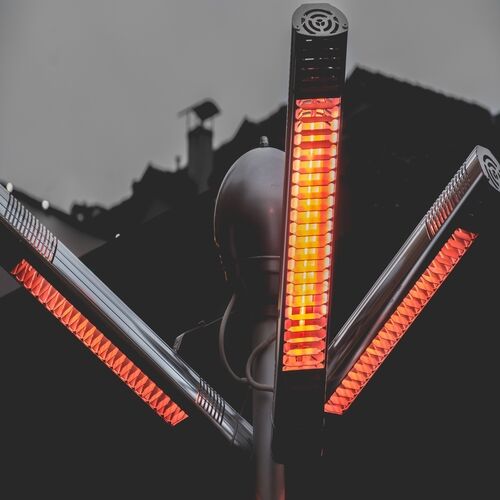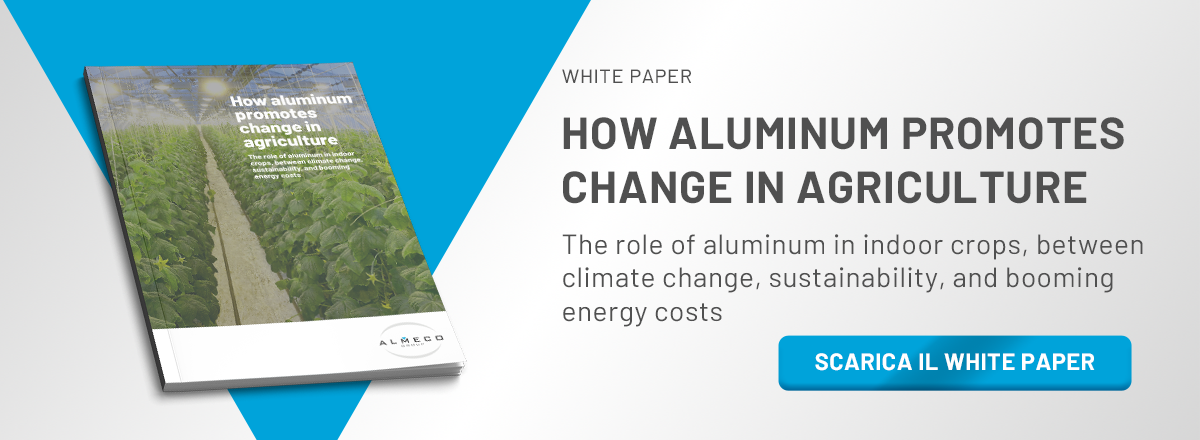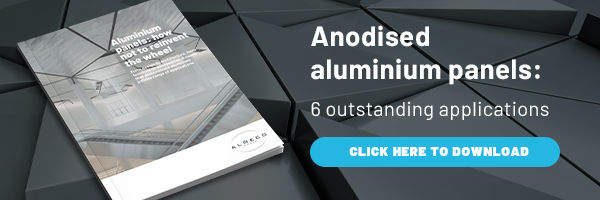Aluminum is a material with excellent capabilities to reflect heating. When treated with special processes – such as anodizing – it is possible to further enhance the capabilities of this metal for highly efficient and innovative indoor and outdoor applications.
However, to avoid excessive concentration of heat and annoying light reflections, a good expertise is needed in the design of the heating system for any specific environment.
With more than half a century of experience in aluminum treatment and state-of-the-art production facilities, Almeco has developed particularly high-performance reflective surfaces that are ideal for both more “classic” and lesser-known applications.
Surfaces for maximising infrared heating: Almeco’s Infrared Surfaces catalogue
Almeco’s catalogue includes high-reflective aluminum surfaces designed specifically to manage the infrared heating radiation.
Depending on the application and their needs, customers can choose between two types of Infrared surfaces:
- IR19, where the surface is coated with a thin oxide layer and has, therefore, a higher reflective capacity.
- IR10, which is characterised by a thicker oxide layer that makes the surface more resistant to weather conditions.
IR19 surfaces are ideal for indoor heating, while IR10 it’s the right choice for outdoor applications. Almeco portfolio in the Infrared Surfaces catalogue, moreover, can be manufactured with two types of finishes: smooth, thus mirror-like, which generates a more direct and concentrated beam of light, ideal for applications such as heating big spaces.
The hammered effect, on the other hand, allows to distribute the heat in a more diffuse and homogeneous way. It therefore finds use in those applications where the reflector is closer to the surface to be radiated or where a more diffuse radiation is desired.
Infrared heating with aluminium surfaces, some common applications
The use of aluminum to spread the heat produced by infrared radiation is already widely used in some contexts, such as in outdoor heating in restaurants and clubs.
Infrared heating is much more efficient than conventional heating, as it is possible to direct the heating towards objects or people. Additionally, as the heat radiates in the form of waves, it is not absorbed by the air, but it has a direct effect on people, so all the energy produced is used for the purpose of the application. This can translate into up to 50% of cost saving compared to conventional heating.
Infrared heating is also much more sustainable compared to conventional heating: in addition to the reduced energy consumption required and minimal heat loss, infrared heating does not require any combustion, as the heating is not generated through warming up air. Thus, not only the environmental footprint of heating is reduced – which is particularly relevant for outdoor applications – but there is also no direct emission of any pollutants into the air.
These heating systems thus create a healthier and more pleasant environment. Therefore, they find use in various applications, such as wellness centres, as well as in large spaces that are not insulated or do not retain heat easily, such as hotels, bars and restaurants.
Infrared heating, the advantages for industrial settings
These infrared heating surfaces can also help industrial companies to make their production processes more efficient and reduce energy costs. In the automotive industry, for example, aluminum reflective surfaces are used to speed and optimize the dry process of the painted parts of the vehicle.
In the industrial setting, these reflectors can be used also to harness the heat produced by pipes where hot water or air passes, usually located high above. By coating these pipes with highly reflective aluminum surfaces it is possible to redirect heat downwards, so that it is not lost and can be used to heat the premises. In this way, manufacturing companies can cut the energy needed to heat the halls and thus operate more sustainably.
Less common and innovative applications
In addition to these established applications of infrared heating, more curious and unique uses are beginning to appear, especially indoors. Almeco IR surfaces, for example, have been used to make a “Sunshower”. This special shower has a band (protected by glass) where the infrared lamp is placed, which, thanks to the heat produced, allows the muscles to relax.
A Swedish company has instead used these highly reflective surfaces to design a keyboard heating system, which improves the user experience of its workers in colder weather.
These curious applications demonstrate that, when it comes to a material with so many characteristics and properties, such as aluminum, relying on a partner with long experience in its treatment, as Almeco, opens to countless application possibilities.
IR in horticultural (TBC)
In recent years, people have also begun to look at these surfaces for applications in the horticulture sector, especially following the increasing adoption of greenhouses. In horticulture, traditionally, 1000-watt discharge lamps were used, which convert around 50% of the energy into light and the rest into heat. The great advantage of their use was in the ability to provide both light and heat through a single source.
Today the LED sources are mainly used due to a wider spectrum light efficacy, but, since they are “cold” sources (no heat emitted by the diods), they can be combined to a IR heater to recreate the ideal environment for the growth of the plants.
Almeco’s reflective surfaces for infrared heating find application in the horticultural sector as well, where they can help boost LED luminaires performances to further improve the cultivation process.


